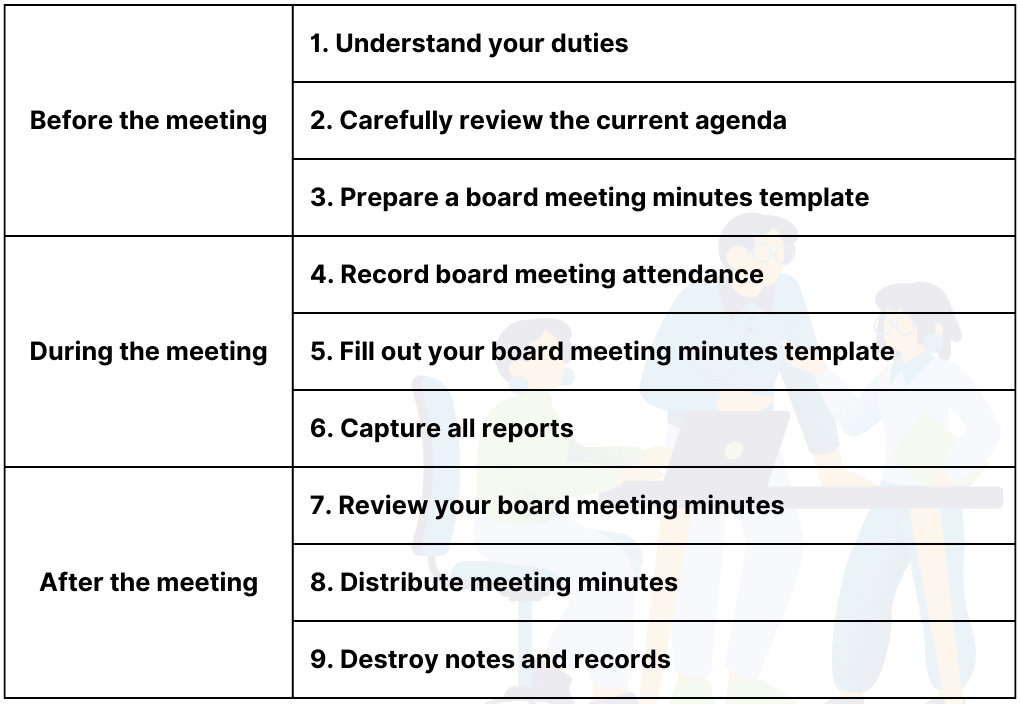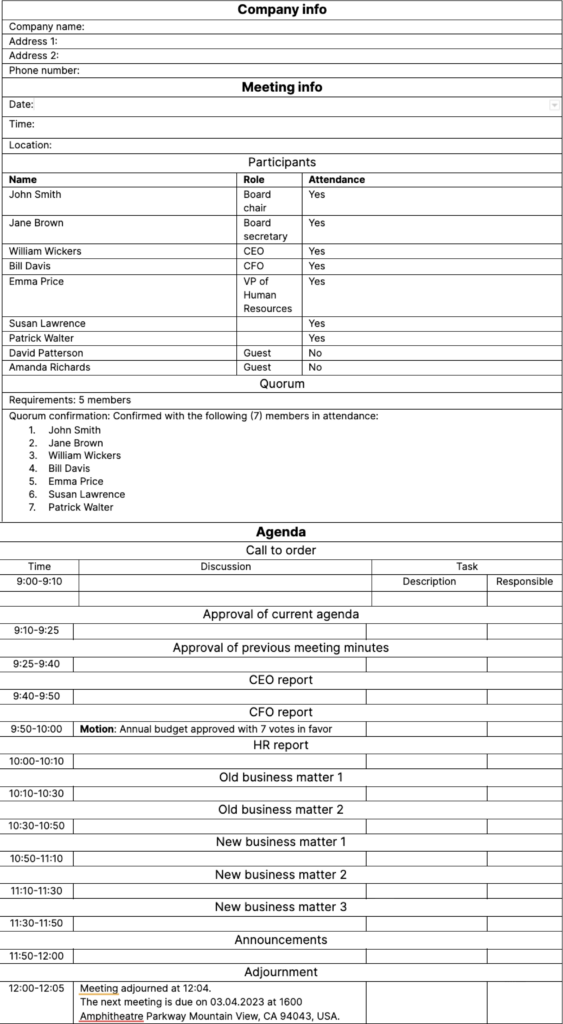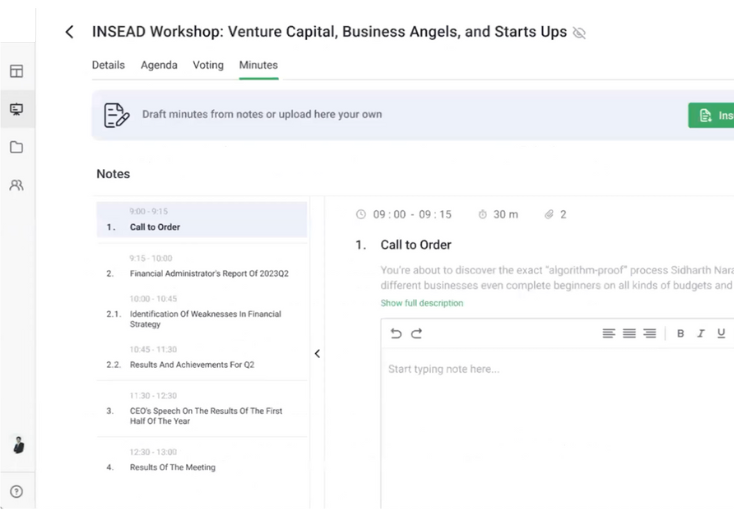Studies have found that 36% of board secretaries experience challenges with information processes, from preparing agendas to writing meeting minutes. Fortunately, you’re in the right place if you want to be in the 64% part that excels at board meetings.
This time, you will learn how to take minutes in a board meeting. Keep reading to discover four meeting minute writing mistakes and four tips on taking good meeting minutes at a board meeting. Finally, get a sample board meeting minutes template and learn what board software can help.
What Are Board Meeting Minutes?
Board meeting minutes are the written document produced from notes taken during the board meeting. It illustrates the decisions made, votes taken, and absences noted. Furthermore, it is a legal document, which can provide necessary insight into the inner workings of a company.
The job of documenting a board meeting is usually delegated to the secretary. They are responsible for taking notes during the event. After it is concluded, they need to prepare the official board of directors meeting minutes record. Most places in the world require that as a legal document, but there isn’t a special meeting minutes format to which you need to adhere. A well-prepared template could help the company be as transparent as possible. We will show you how to take meeting minutes at board meetings.
How to take minutes at a board meeting?
We already know why those board meeting minutes are important, but how to create such documents? At the end of the article, you will have the opportunity to look at basic templates for this occasion. To make your note-taking even more efficient, we recommend using board portals, keeping in mind the best practices below:
- Easily create an agenda and keep track of accordance with it. Taking notes inside board software is a convenient way of creating board meeting minutes. You can use templates, track attendance, and attach motions. Through board portals, you can focus more on the meeting, as actions like creating new agendas are easily undertaken.
- Use a ready-made agenda template in a convenient meeting minutes format. Relying on templates makes the job of a secretary almost effortless. Agendas attached to the meeting invites will be accessible in the board portal, across many meetings. It is a convenient way of keeping data categorized.
- Mind the information that should be included or excluded in the meeting minutes. While recording the meetings also remember which information is important to be included in the document. This is a file consisting of impersonal documentation, so you should not mention who voted for and who voted against a motion. Off-the-record and personal remarks should also be exempt from board meeting minutes. You can also include links to the presentations that took place in the meeting.
These considerations will help you be on the same page with the directors while taking minutes at a board meeting. But they will only be effective if you consider a few practices before, during, and after board meetings:

Before the meeting: How to prepare for taking meeting minutes?
1. Understand your duties
Refreshing your understanding of duties as a board secretary and minute-taker is a good idea. For this, you can study Robert’s Rules of Order, a set of US parliamentary standards on how to take minutes of a board meeting.
This document describes the general duties of the board secretary. However, a particular organization may follow unique guidelines and requirements for taking meeting minutes.
It will be wise to consult your board president to clarify your responsibilities during the meeting. Otherwise, you can easily overlook some of your duties and unintentionally violate your board’s policies.
2. Carefully review the meeting agenda and previous meeting’s minutes
You should revise the board meeting agenda to understand what actions and decisions you might record in the upcoming meeting.
A good secretary also reviews reports, supporting documents, and previous meeting minutes. It will help you estimate how much time each agenda item takes based on previous experience
Understanding the sequence and context of the upcoming discussion will help you navigate the meeting. In turn, this will allow for more accurate meeting minute records. It is also much more convenient with board management software.
3. Prepare a board meeting minutes template
A good board meeting minutes template reflects your agenda so that you can set timestamps and write details under each agenda item. This way, you can capture the most details as fast as possible.
Therefore, it’s better to prepare such a template beforehand and keep it next to your agenda during the meeting.

During the meeting: How to take board minutes?
4. Record board meeting attendance
Record attendees, including those arriving late, and absent board members as soon as the meeting starts. It’s much easier to record meeting attendance and track the participants in a virtual board meeting.
But if it’s a physical meeting, you can print meeting sign-in sheets in advance and hand them to the board directors right before the meeting.
5. Fill out your board meeting minutes template
You can start taking meeting minutes once the board chair officially opens the meeting. Fill out the template you have prepared in advance. Robert’s Rules of Order provides the following aspects to cover in the board meeting minutes:
- The meeting date, time, and location. Indicate whether it is a regular, special, emergency, closed, or rescheduled meeting.
- Attendees and absent participants. List the names and roles of present and absent participants.
- Approval of previous meeting minutes. Indicate whether past meeting minutes were approved or amended, and state the approver’s name.
- Board’s actions. Record motions, proposals, and decisions within each agenda item.
- Meeting opening and adjournment hours. State the official call to order and adjournment time and indicate the next meeting’s location, date, and time.
6. Capture all reports
If board members introduce new reports during the meeting, you should ask for their copies. As a board secretary, you are responsible for documentation and legal records before, during, and after board meetings. Therefore, ensure your meeting minutes capture all available reports.
After the meeting: How to write board meeting minutes?
7. Review your board meeting minutes
You should review your records and make the necessary edits as soon as possible post-meeting. Your fresh memory will let you write down as many details as possible and prepare accurate meeting minutes. Once the meeting finishes, you can create official meeting minutes, ready for review during the next meeting.
8. Distribute meeting minutes
Submit your meeting minutes to the chairperson for approval once you complete them. Once your meeting minutes draft gets approved, you can send them to all board members, both meeting participants and absent board directors.
You can distribute them via email. However, unlike board portals, emails put boards at significant confidentiality risk. IBM reported that 83% of organizations had more than one data breach.
On average, one data breach costs $4.35 million, exceeding any imaginable pricing of board portals.
9. Destroy notes and records
The Center for Association and Leadership advises board secretaries to destroy notes, drafts, and records of meeting minutes once the board chair approves the final draft.
The approved and distributed meeting minutes version should be the only document left. It is necessary to avoid confidentiality risks and keep your board safe from potential litigation.

4 common mistakes while taking board meeting minutes
Ensure you avoid these four mistakes while writing board meeting minutes.
1. Missing the quorum
| “A quorum refers to the minimum acceptable level of individuals with a vested interest in a company needed to make the proceedings of a meeting valid under the corporate charter.” @Investopedia |
Meeting minutes that fail to record a quorum are invalid even if the meeting had enough attendees. Or, the quorum may be present at the start but gets lost due to some board members leaving the discussion early.
- Solution. Carefully track attendance and state whether the meeting meets quorum requirements once any changes in attendance occur.
2. Adding too much detail
Meeting minutes summarize essential points of the meeting to inform both absent and future board directors and future board members. Long meeting minutes may perplex board directors and take too much approval time during the next meeting.
Also, overly detailed meeting minutes may open your board to legal liability, as someone can easily interpret out-of-context discussions against you.
- Solution. Avoid recording side discussions, transcribing debates, or adding personal comments.
3. Omitting key details
Poorly detailed meeting minutes also harm boards of directors. Meeting minutes that miss critical details may distort board decisions and lead the board in the wrong direction. Board members will also spend a considerable part of the meeting approving such meeting minutes.
- Solution. Stick to a board meeting minutes template to create consistently detailed records. Also, render as many details as to make meeting minutes clear to board directors five years in the future.
4. Using vague language
Effective meeting minutes provide legal protection for the board of directors, defending them against legal issues due to an accurate and official meeting record.
However, meeting minutes containing vague and unclear language may cause a big legal trouble for your board if any proceeding occurs. Meeting minutes with double meanings may be incorrectly interpreted in court and lead to devastating consequences.
- Solution. Ensure your records carry direct meaning and leave no space for speculation. Stick to the facts and be as precise as possible.

4 best practices to take board meeting minutes effectively
Check these four tips on how to record minutes of a board meeting to enhance your minute-taking experience.
1. Ask for clarifications
Board etiquette doesn’t allow board members to interrupt each other, but the board secretary or another minute-taker is an exception. Feel free to stop the meeting and ask the speaker for clarifications if you miss any details. However, try doing so after the topic changes to keep the discussion smooth and polite.
2. Use a voice recorder
Charities Review Council advises board secretaries to record the precise wording of motions and resolutions. Sometimes it’s barely possible without a voice recorder, and you can use one if your board policies allow it. Voice meeting records will safeguard you from inaccurate statistics, misinterpreted statements, and other error-sensitive meeting details. You can return to central decisions as many times as you need.
Once you finish the meeting minutes, make sure you destroy voice records. Don’t let them fall into the wrong hands, or they can put everyone involved at significant risk.
3. Back up minute-taking tools
Many will agree that typing meeting minutes using a laptop is the best way, but technology may fail at the least expected moment.
For instance, Pew Research.org finds that 39% of laptop users have their machines not working as expected at some time. Therefore, you should take backup tools, such as pens and notebooks, just in case, and print your meeting minutes template.
4. Have a nice sleep before the meeting
Your brain is the most powerful tool during a board meeting, and you should also keep it ready and ensure it doesn’t fail. However, it often fails if you don’t sleep enough. Even short sleep deprivation impairs concentration and judgment and is equal to taking a few drinks.
Therefore, you should sleep well before the meeting to take effective board meeting minutes. If anticipation puts you under stress, you can do some relaxation routines or take sleep aid medication before bed.
Board meeting minutes template
While we should focus our attention on the meeting while documenting board meeting minutes, templates help us in a more efficient note-taking. This is why we prepared a couple of board of directors meeting minutes templates. We present you with a meeting minutes example and hope it will be helpful:

You can get a copy of our template at link
How To Use The Board Portal For Effective Meeting Minutes?
Meeting minutes builders included in the board portals are a great help in crafting those important documents. There are a couple of tools, which especially contribute to a more efficient workflow.
- The aforementioned agenda templates are a great way of keeping vital corporate information organized. They reduce the time it takes to note during the meeting.
- Through the builder, you are also able to attach assignments to adequate people. This helps to keep track of who does what in the company.
- If you have things you need to highlight, use cursive or bold text. Those are also tools that can be accessed in the meeting minutes builder. These formatting tools can help organize thoughts in the file.
- After you are done with crafting your board meeting minutes, you can export the document into one of the most common file formats like PDF or Word Doc. The file can be accessed on almost any device.

| Unsure what board software to use? Consider iDeals Board! This virtual boardroom automatically counts votes, tracks attendees, and records task activity. It relieves you from manual administrative work, letting you listen carefully, focus on key decisions, and take meeting minutes in interactive meeting agendas. |
The bottom line
Board meeting minutes are legal documents representing critical decisions, votes, and resolutions made during board meetings.
To write quality board meeting minutes, you should prepare in advance, make detailed notes during the meeting, and use a meeting minutes template. You should also keep your meeting minutes concise, factual, and unbiased.
You can also use a secure board portal as an all-in-one tool for effective minute-taking. It allows you to securely record and distribute minutes in the interactive agenda while easily adding timestamps, attaching reports, and tracking attendees.
FAQ
How detailed should meeting minutes be?
Board meeting minutes serve as an official record of the major points of the meeting and provide pivotal details on decisions, votes, and resolutions. Meeting minutes should exclude the meeting’s written transcript, opinions, or reports’ details.
How to take effective board meeting minutes?
To take effective board meeting minutes, you should prepare a meeting agenda, use a board meeting template, and take notes during the meeting. You can also ask for clarifications and take backup minute-taking tools.
Are board meeting minutes confidential?
Board meeting minutes are highly confidential information and should not be available to third parties except under legal investigation. A minute-taker should include as many details in the meeting minutes as to show that board directors fulfill their duties.
Who signs board meeting minutes?
A board secretary should sign board meeting minutes before submitting them for approval. The meeting minutes should get a board president’s signature during the next board meeting.